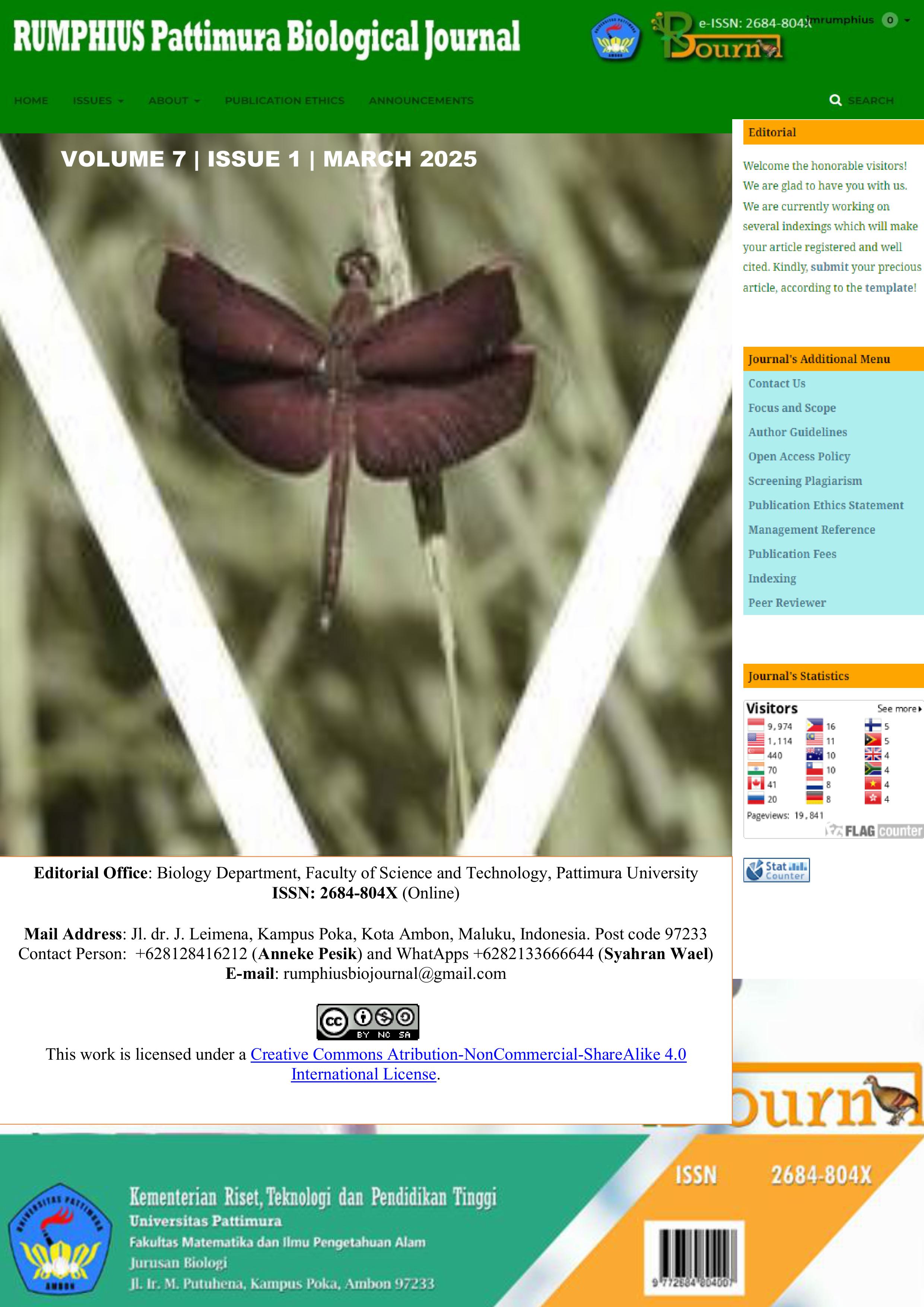Community Study of Local Fruit Producing Trees of Economic Value in Uraur Village, West Seram District
Abstract
Local fruit is one type of natural wealth in Indonesia which has many benefits in the economic sector. Local fruit plants in Indonesia are a fairly large source of income in the agricultural sector to help the community's economy, especially the people of Maluku Province. Uraur Village is one of the villages in Maluku Province. This research aims to determine and explain the community structure and habitat of local fruit-producing trees, including tree types, number of individuals, density, frequency, dominance, importance value index and diversity index. The method used is quantitative descriptive. The environmental parameters measured are soil and air temperature, soil and air humidity, pH and light intensity. The results of this research found 19 types of local fruit plants with 12 families and 12 genera with species diversity belonging to the medium category. Environmental parameters at the research location support the growth of local fruit plants because the habitat at the research location is relatively good. Air temperature ranges from 29-35oC, soil temperature ranges from 28.4-32.16oC, air humidity ranges from 44-68%, soil moisture ranges from 28.4-32.2%, pH 7 and light intensity ranges from 694 -1541 lux.
Downloads
References
Arrijani A. (2008). Vegetation structure and composition of the montane zone of Mount Gede Pangrango National Park. Biodiversitas, Journal of Biological Diversity, 9(2), 134–141.
Augustyn, G. H. (2013). The Study of Food Consumption in Rural Communities Kawatu and Uraur at Kairatu Sub District. Jurnal Agribisnis Kepulauan .Vol 2. No. 2
Cahyaningprastiwi, S. R., Karyati, & S. Sarminah. (2021). Soil Temperature and Humidity at Different Topographic Position and Soil Depths in Taman Sejati Samarinda City. Agrifor: Jurnal Ilmu Pertanian dan Kehutanan. 20 (2): 189–198.
Ismail, M. H., Fadli, M., Fuad, A., Zaki, P. H., Janatun, N., & Jemali, N. (2017). Analysis of importance value index of unlogged and logged peat swamp forest in Nenasi Forest Reserve , Peninsular Malaysia. 7(2), 74–78.
Ismaini, L., Masfiro L., Rustandi, Dadang S. (2015). Composition and plant diversity analysis on Mount Dempo, South Sumatra. Prosiding Seminar Nasional Masyarakat Biodiversitas Indonesia, 1(6), 1397-1402.
Magurran, A. E., 1988. Ecological Diversity and Its Measurement. New Jersey (US): Princeton University Press.
Maisyaroh W. (2010). Structure of Ground Cover Plant Community R . Soerjo Grand Forest Malang. Pembangunan Dan Alam Lestari, 1(1), 1–9.
Meilianto W. D., Widyaningrum I., & Esmar B. (2022). Characterization of soil temperature and moisture sensors for soil quality measurement system applications. Prosiding Seminar Nasional Fisika (E-journal) 10: 117-121. https://doi.org/10.21009/03.SNF2022.01.FA.16
Pithaloka S.A., Sunyoto S., Muhammad K., & Kuswanta F.H. (2015). The effect of plant density on growth and yield of several sorghum varieties (Sorghum bicolor (L.) Moench). Jurnal Agrotek Tropika 3(1): 56-63. https://doi.org/10.23960/jat.v3i1.1948
Pradana M.R., Mochammad H.H.I., & Sabriansyah R.A. (2023). Classification of fertility and measurement of soil moisture coverage in red guava plants based on Arduino. Jurnal Pengembangan Teknologi Informasi dan Ilmu Komputer 7 (4): 1797-1809.
Rizky & Elza, S.(2016). Composition of trees on ace hill, gunung village sarik, kuranji district, padang. Journal of Sainstek, Vol.8(2): 142-149.
Tri, H. S., Indung, S. F dan Bambang, S. (2010). Study of The Paving Area Effect on Air Temperature Change (Case Study of Parking Area at Plaza Senayan, Sarinah Thamrin, and Gambir Station). Lanskap Indonesia, 2(2):76 - 82.
Copyright (c) 2025 Kristin Aprilsya, Evelin Tuhumuri, Petrus Lapu

This work is licensed under a Creative Commons Attribution-NonCommercial-ShareAlike 4.0 International License.
Authors who propose a manuscript and have it approved for publication know that the manuscript will be registered and become part of the RPBJ. Authors and readers understand that this journal is open and all its contents can be accessed freely, provided that RPBJ is still listed as the source of information. The hope is that this journal can become a vehicle for exchange and scientific knowledge for society and the scientific community, especially in the field of Biology and other branches of science.









